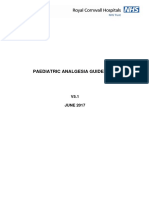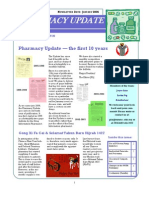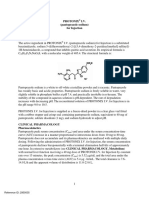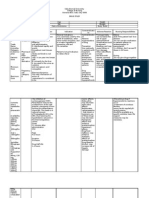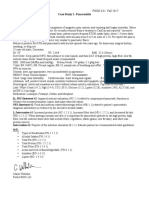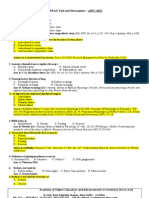0 ratings0% found this document useful (0 votes)
37 viewsPanadol Osteo Product Information: Name of The Medicine Active Ingredients Chemical Structure CAS Registry Number
Panadol Osteo Product Information: Name of The Medicine Active Ingredients Chemical Structure CAS Registry Number
Uploaded by
honeysutton8This document provides product information for PANADOL OSTEO, including its active and inactive ingredients, pharmacology, clinical trials, indications, contraindications, and precautions. It describes how PANADOL OSTEO contains both immediate and sustained release paracetamol to provide up to 8 hours of pain relief. Clinical trials showed it was equivalent to standard immediate release paracetamol for both chronic and acute pain. The document contains extensive details on the pharmacokinetics and metabolism of paracetamol.
Copyright:
© All Rights Reserved
Available Formats
Download as PDF, TXT or read online from Scribd
Panadol Osteo Product Information: Name of The Medicine Active Ingredients Chemical Structure CAS Registry Number
Panadol Osteo Product Information: Name of The Medicine Active Ingredients Chemical Structure CAS Registry Number
Uploaded by
honeysutton80 ratings0% found this document useful (0 votes)
37 views8 pagesThis document provides product information for PANADOL OSTEO, including its active and inactive ingredients, pharmacology, clinical trials, indications, contraindications, and precautions. It describes how PANADOL OSTEO contains both immediate and sustained release paracetamol to provide up to 8 hours of pain relief. Clinical trials showed it was equivalent to standard immediate release paracetamol for both chronic and acute pain. The document contains extensive details on the pharmacokinetics and metabolism of paracetamol.
Original Description:
gcp
Original Title
gcppanos
Copyright
© © All Rights Reserved
Available Formats
PDF, TXT or read online from Scribd
Share this document
Did you find this document useful?
Is this content inappropriate?
This document provides product information for PANADOL OSTEO, including its active and inactive ingredients, pharmacology, clinical trials, indications, contraindications, and precautions. It describes how PANADOL OSTEO contains both immediate and sustained release paracetamol to provide up to 8 hours of pain relief. Clinical trials showed it was equivalent to standard immediate release paracetamol for both chronic and acute pain. The document contains extensive details on the pharmacokinetics and metabolism of paracetamol.
Copyright:
© All Rights Reserved
Available Formats
Download as PDF, TXT or read online from Scribd
Download as pdf or txt
0 ratings0% found this document useful (0 votes)
37 views8 pagesPanadol Osteo Product Information: Name of The Medicine Active Ingredients Chemical Structure CAS Registry Number
Panadol Osteo Product Information: Name of The Medicine Active Ingredients Chemical Structure CAS Registry Number
Uploaded by
honeysutton8This document provides product information for PANADOL OSTEO, including its active and inactive ingredients, pharmacology, clinical trials, indications, contraindications, and precautions. It describes how PANADOL OSTEO contains both immediate and sustained release paracetamol to provide up to 8 hours of pain relief. Clinical trials showed it was equivalent to standard immediate release paracetamol for both chronic and acute pain. The document contains extensive details on the pharmacokinetics and metabolism of paracetamol.
Copyright:
© All Rights Reserved
Available Formats
Download as PDF, TXT or read online from Scribd
Download as pdf or txt
You are on page 1of 8
PANADOL
OSTEO Product Information Page 1 of 8
PANADOL OSTEO
PRODUCT INFORMATION
NAME OF THE MEDICINE
Active ingredients Chemical structure CAS Registry Number
Paracetamol
103-90-2
DESCRIPTION
White to off-white film coated capsule shaped tablets with flat edges. Embossed with the
logo 8 on the front face and plain on the back face.
Active Ingredient: Paracetamol 665 mg
Excipients: Hypromellose, Starch pregelatinised maize, Povidone, Croscarmellose sodium,
Magnesium stearate, Stearic acid, Glycerol Triacetate, Carnauba wax
Contains no sugar, lactose or gluten.
PHARMACOLOGY
Paracetamol is a para-aminophenol derivative that exhibits analgesic and anti-pyretic activity.
Its mechanism of action is believed to include inhibition of prostaglandin synthesis, primarily
within the central nervous system. It does not possess anti-inflammatory activity. It provides
relief from mild to moderate pain and fever.
Pharmacodynamics
The combination of immediate release and sustained release paracetamol provides pain
relief, which may last up to 8 hours.
PANADOL
OSTEO Product Information Page 2 of 8
Pharmacokinetics
Absorption
Paracetamol is rapidly and almost completely absorbed from the gastrointestinal tract. Food
intake delays paracetamol absorption.
PANADOL OSTEO is a unique bi-layer tablet incorporating an immediate release and a
sustained release dose of paracetamol.
The sustained release layer contains HPMC polymer, which rapidly hydrates to form a gel
layer at the matrix periphery. The drug is then released from the matrix by a combination of
diffusion and erosion of the gel layer.
Bioequivalence
PANADOL OSTEO releases drug at a rate which ensures that therapeutically active plasma
paracetamol concentrations are rapidly attained and maintained until up to 8 hours after
administration.
PANADOL OSTEO and standard immediate release paracetamol were bioequivalent in
volunteers with respect to dose-corrected AUC
(0-t)
and AUC
(0-inf)
in both the fed and fasted
states following administration of a single dose. This indicates that the extent of paracetamol
absorption from PANADOL OSTEO was equivalent to that of standard immediate release
paracetamol. Food had little effect on the extent of paracetamol absorption from PANADOL
OSTEO demonstrating that PANADOL OSTEO is suitable to be taken with or without meals.
Paracetamol was rapidly absorbed after administration of PANADOL OSTEO and was
generally measurable in plasma within 15 minutes in fasted subjects. Mean plasma
paracetamol concentrations above the minimum level required for analgesia (>4mcg/mL)
were maintained until up to 6 to 7 hours after administration in fasted subjects and 7 to 8
hours in fed subjects.
At steady state, PANADOL OSTEO was bioequivalent with standard immediate release
paracetamol based on the comparison of AUCs during the final 24 hour dosing period of the
study. Furthermore, comparison of the pharmacokinetic parameters indicated that
PANADOL OSTEO has the characteristics of a formulation containing sustained release
paracetamol.
Fluctuations in the peak and trough values for plasma paracetamol concentrations were
significantly smaller for PANADOL OSTEO than for standard immediate release paracetamol
(mean fluctuation index = 0.957 and 1.388, respectively, p<0.001). Consequently, PANADOL
OSTEO provided more consistent levels of paracetamol. Furthermore, the AUCs at steady
state were equivalent indicating that there was no additional accumulation of paracetamol
from PANADOL OSTEO compared to standard immediate release paracetamol.
Distribution
Paracetamol is distributed into most body tissues. Binding to the plasma proteins is minimal
at therapeutic concentrations but increases with increasing doses.
PANADOL
OSTEO Product Information Page 3 of 8
Metabolism
Paracetamol is metabolised extensively in the liver and excreted in the urine mainly as
inactive glucuronide and sulfate conjugates. The metabolites of paracetamol include a minor
hydroxylated intermediate which has hepatotoxic activity. This intermediate metabolite is
detoxified by conjugation with glutathione. However, it can accumulate following paracetamol
overdosage (more than 150 mg/kg or 10 g total paracetamol ingested) and if left untreated
can cause irreversible liver damage.
Paracetamol is metabolised differently by premature infants, newborns, infants and young
children compared to adults, the sulphate conjugate being predominant.
1
Excretion
Paracetamol is excreted in the urine mainly as the glucuronide and sulphate conjugates.
Less than 5% is excreted unchanged. Approximately 85% of a dose of paracetamol is
excreted in urine as free and conjugated paracetamol within 24 hours of ingestion.
Administration of paracetamol to patients with moderate to severe renal impairment may
result in accumulation of paracetamol conjugates.
2
The elimination half-life varies from one to
three hours.
CLINICAL TRIALS
Chronic Pain
In patients with pain associated with osteoarthritis of the knee, PANADOL OSTEO (2 tablets
taken three times daily) and standard immediate release paracetamol (2 tablets taken 4 times
daily) were clinically equivalent at a total daily dose of 4 g based on patient global
assessment after treatment for 7 days.
PANADOL OSTEO and standard immediate release paracetamol were not significantly
different for a range of secondary efficacy parameters including pain during the day, pain on
walking, pain relief, number of times woken during the night due to pain and duration or
morning stiffness.
Since PANADOL OSTEO (three times daily) was clinically equivalent to standard immediate
release paracetamol (four times daily), it was concluded that PANADOL OSTEO provides
pain relief for up to 8 hours after dosing.
Acute Pain
In patients with post-surgical dental pain, a single dose of PANADOL OSTEO (2 tablets) was
therapeutically equivalent to standard immediate release paracetamol (2 tablets) based on
patient global assessment 4 hours after treatment. Onset of action was apparent 30 minutes
after administration.
There was no significant difference between PANADOL OSTEO and standard immediate
release paracetamol in either development of analgesia or peak analgesic effect. Trends in
favour of PANADOL OSTEO were observed at the later time points. Furthermore, PANADOL
1
Core Paracetamol PI
2
American Hospital Formulary Service Drug Information 2012
PANADOL
OSTEO Product Information Page 4 of 8
OSTEO was significantly more effective than standard immediate release paracetamol for the
summed pain intensity difference at 6 hours (p = 0.0344) and 8 hours (p = 0.0500), as
measured on a visual analogue scale.
Summary
From these results, it was concluded that PANADOL OSTEO has a similar time to onset of
action compared to standard immediate release paracetamol and provides more prolonged
analgesia than standard immediate release paracetamol. For the patient, this translates to
longer lasting pain relief and the improved convenience of fewer doses. This is as expected
for a formulation containing sustained release paracetamol and consistent with results from
the pharmacokinetic studies.
INDICATIONS
PANADOL OSTEO provides effective relief from persistent pain for up to 8 hours. Effective
for the relief of persistent pain associated with osteoarthritis and muscular aches and pains
such as backache. Provides effective temporary relief of pain and discomfort associated with:
headache, tension headache, cold and flu, period pain, toothache and pain after dental
procedures. Reduces fever.
CONTRAINDICATIONS
PANADOL OSTEO is contraindicated in patients with a previous history of hypersensitivity to
paracetamol or any of the exipients.
PRECAUTIONS
Underlying liver disease increases the risk of paracetamol-related liver damage. Patients
who have been diagnosed with liver or kidney impairment must seek medical advice before
taking this medication.
If symptoms persist, medical advice must be sought.
Keep out of sight and reach of children.
Use in pregnancy
Category A
Paracetamol has been taken by a large number of pregnant women and women of
childbearing age without any proven increase in the frequency of malformations or other
direct or indirect harmful effects on the foetus having been observed.
Maternal ingestion of paracetamol in usual analgesic does not appear to present a risk to
breastfed infants.
3
3
Core Paracetamol PI
PANADOL
OSTEO Product Information Page 5 of 8
Use in Lactation
Paracetamol is excreted in breast milk. Human studies with paracetamol have not identified
any risk to lactation or the breast-fed offspring. These results are based on immediate
release preparations of paracetamol. There is no data available on the excretion of
sustained-release paracetamol preparations in breast milk. However, it is not expected that
PANADOL OSTEO would provide any increase in the excretion of paracetamol in breast milk
as this product is designed to maintain rather than increase plasma paracetamol
concentrations compared to immediate release preparations. Maternal ingestion of
paracetamol in usual analgesic doses does not appear to present a risk to the breastfed
infant.
Use in Children
Not recommended for children under 12 years of age.
INTERACTIONS WITH OTHER MEDICINES
The following interactions with paracetamol have been noted:
The anticoagulant effect of warfarin and other coumarins may be enhanced by prolonged
regular daily use of paracetamol with increased risk of bleeding. Anticoagulant dosage may
require reduction if paracetamol and anticoagulants are taken for a prolonged period of time.
Paracetamol absorption is increased by substances that increase gastric emptying, eg
metoclopramide.
Paracetamol absorption is decreased by substances that decrease gastric emptying, eg
propantheline, antidepressants with anticholinergic properties and narcotic analgesics.
Paracetamol may increase chloramphenicol concentrations.
The risk of paracetamol toxicity may be increased in patients receiving other potentially
hepatotoxic drugs or drugs that induce liver microsomal enzymes such as alcohol and
anticonvulsant drugs.
Paracetamol excretion may be affected and plasma concentrations altered when given with
probenecid.
Colestyramine reduces the absorption of paracetamol if given within one hour of
paracetamol.
PANADOL
OSTEO Product Information Page 6 of 8
ADVERSE REACTIONS
Adverse events from historical clinical trial data are both infrequent and from small patient
exposure. Accordingly, events reported from extensive post-marketing experience at
therapeutic/labelled dose and considered attributable are tabulated below by System Organ
Class and frequency.
The following convention has been utilised for the classification of undesirable effects: very
common (1/10), common (1/100, <1/10), uncommon (1/1,000, <1/100), rare (1/10,000,
<1/1,000), very rare (<1/10,000), not known (cannot be estimated from available data.
Adverse event frequencies have been estimated from spontaneous reports received though
post-marketing data.
Body System Undesirable Effect Frequency
Blood and lymphatic system
disorders
Thrombocytopenia Very rare
Immune system disorders Anaphylaxis
Cutaneous hypersensitivity
reactions including skin
rashes, angioedema and
Stevens Johnson syndrome
Very rare
Respiratory, thoracic and
mediastinal disorders
Bronchospasm Very rare
Hepatobiliary disorders Hepatic dysfunction Very rare
DOSAGE AND ADMINISTRATION
Adults and children aged 12 years and over: 2 caplets swallowed whole three times a day
every 6 to 8 hours. Maximum of 6 caplets in 24 hours
Do not use for more than a few days at a time in adults except on medical advice.
Children under 12 years: Not recommended for children under the age of 12 years.
Should not be used for more than 48 hours for children aged 12 17 years except on
medical advice.
Take with water or other fluid.
Can be taken with or without food.
Doses should be equally spaced throughout the day.
The caplets must not be crushed.
PANADOL
OSTEO Product Information Page 7 of 8
Do not exceed the stated dose.
Should not be used with other paracetamol-containing products.
Minimum dosing interval: 6 hours
Renal and Hepatic impairment
Patients who have been diagnosed with liver or kidney impairment must seek medical advice
before taking this medication. The restrictions related to the use of paracetamol products in
patients with hepatic impairment are primarily a consequence of the paracetamol content of
the drug. (See PREACUTIONS.)
OVERDOSAGE
Poisons Information Centre
If an overdose is taken or suspected, contact the Poisons Information Centre immediately for
advice (131 126), or the patient should go to the nearest hospital straight away. This should
be done even if they feel well because of the risk of delayed, serious liver damage. (See
ADVERSE EFFECTS.)
Because PANADOL OSTEO is a sustained-release formulation of paracetamol, absorption
will be prolonged in overdose. It is recommended that for the management of overdose,
where PANADOL OSTEO is suspected, that an additional plasma paracetamol level be
obtained 4-6 hours after the initial measurement. If either level is above or close to the
treatment line on the paracetamol overdose nomogram, administration of antidote would be
indicated.
Treatment
Paracetamol overdose may cause liver failure.
Immediate medical management is required in the event of an overdose, even if the
symptoms of overdose are not present.
Administration of acetylcysteine may be required.
In cases of overdosage, methods of reducing absorption of ingested drug are important.
Activated charcoal may reduce absorption of the medicine if given within one hour after
ingestion. In patients who are not fully conscious or have impaired gag reflex, consideration
should be given to administering activated charcoal via a nasogastric tube, once the airway is
protected.
PRESENTATION AND STORAGE CONDITIONS
Active ingredient: Paracetamol 665 mg
PANADOL
OSTEO Product Information Page 8 of 8
White to off-white film coated capsule shaped tablets with flat edges. Embossed with the
logo 8 on the front face and plain on the back face.
Packs of 6 and 96 caplets.
Not all pack sizes may be marketed.
Store below 30C.
NAME AND ADDRESS OF THE SPONSOR
GlaxoSmithKline Consumer Healthcare
82 Hughes Avenue
Ermington
NSW 2115
POISON SCHEDULE OF THE MEDICINE
S2 Pharmacy Medicine
DATE OF FIRST INCLUSION IN THE AUSTRALIAN REGISTER OF THERAPEUTIC
GOODS (THE ARTG)
17.2.2005
DATE OF THE MOST RECENT AMENDMENT
06.11.2012
PANADOL
is a registered trade mark of the GlaxoSmithKline group of companies.
You might also like
- George Bridgman Constructive AnatomyDocument217 pagesGeorge Bridgman Constructive AnatomyMirthyn100% (9)
- Failure To ThriveDocument11 pagesFailure To ThriveFiraFurqaniNo ratings yet
- Pedia Drug StudyDocument11 pagesPedia Drug Studyryan50% (2)
- Panadol Osteo Product InformationDocument5 pagesPanadol Osteo Product Informationsalema2No ratings yet
- Paracetamol TabletDocument5 pagesParacetamol TabletGenina MaylemNo ratings yet
- Febramol: CompositionDocument5 pagesFebramol: CompositionDr.2020No ratings yet
- ENG Au - PI - PERFALGAN - V2.0 - 04sep2009Document20 pagesENG Au - PI - PERFALGAN - V2.0 - 04sep2009Amina TsunNo ratings yet
- Panadol Sinus Relief Original Formula Tablets Product InformationDocument8 pagesPanadol Sinus Relief Original Formula Tablets Product Informationredof markzNo ratings yet
- What Is Pantoprazole?Document9 pagesWhat Is Pantoprazole?tdlfNo ratings yet
- PROIECT Managementul Activitatii de Traducator. Malear IrinaDocument11 pagesPROIECT Managementul Activitatii de Traducator. Malear IrinaOffice Hydro-CarpatiNo ratings yet
- Paracetamol 120 MG Per 5mL Oral Solution - MILPOL SYRUP - Milan Laboratories India Pvt. Ltd.Document7 pagesParacetamol 120 MG Per 5mL Oral Solution - MILPOL SYRUP - Milan Laboratories India Pvt. Ltd.isaacarboledasNo ratings yet
- Pi ParacetamolDocument3 pagesPi ParacetamolmehediazizNo ratings yet
- Beware of Paracetamol ToxicityDocument3 pagesBeware of Paracetamol ToxicityMiftakhur RohmahNo ratings yet
- # Be Used - Kuliah Farmakologi Nsaids - in UsedDocument120 pages# Be Used - Kuliah Farmakologi Nsaids - in UsedAfrina FajarNo ratings yet
- Pil 12339Document2 pagesPil 12339Manojit SarkarNo ratings yet
- CPG Dengue Infection PDF FinalDocument5 pagesCPG Dengue Infection PDF FinalFarahin SulongNo ratings yet
- Analgesia Guidelines PaediatricDocument23 pagesAnalgesia Guidelines PaediatricsyahmiNo ratings yet
- Paracetamol: Al-Ayen University College of PharmacyDocument8 pagesParacetamol: Al-Ayen University College of Pharmacyمحمد حميد عطيةNo ratings yet
- Panadol Paracetamol: Medical UseDocument5 pagesPanadol Paracetamol: Medical UseAbdelrhman AboodaNo ratings yet
- Paracetamol 500mg Tablets - Summary of Product Characteristics (SMPC) - Print Friendly - (EMC)Document4 pagesParacetamol 500mg Tablets - Summary of Product Characteristics (SMPC) - Print Friendly - (EMC)Ira PuspitaNo ratings yet
- Chemsitry Paracetamol ProjectDocument17 pagesChemsitry Paracetamol Projectjatinsinghal0808No ratings yet
- Analgesia Guidelines PaediatricDocument28 pagesAnalgesia Guidelines PaediatricGumarbio Setiadi ZakariaNo ratings yet
- Painkillers, Paracetamol: Types of Paracetamol ProductsDocument6 pagesPainkillers, Paracetamol: Types of Paracetamol ProductsKarina Mega WNo ratings yet
- Mention Recent Breakthroughs That Have Impacted HealthcareDocument40 pagesMention Recent Breakthroughs That Have Impacted HealthcareShereen OrtizNo ratings yet
- Paracetamol Package InsertDocument3 pagesParacetamol Package InsertDiane ApostolNo ratings yet
- Paracetamol Use Dec 2008Document30 pagesParacetamol Use Dec 2008Nararto PrijogoNo ratings yet
- Propofol: Prof. Ramadan A. M Hemeida Dr. Remon Roshdy Rofaeil Dr. Ali Khames Dr. Mohammed NabilDocument13 pagesPropofol: Prof. Ramadan A. M Hemeida Dr. Remon Roshdy Rofaeil Dr. Ali Khames Dr. Mohammed NabilAbdelrhman AboodaNo ratings yet
- Panadol - Sri - Lanka Medicine Panadol 1000pc Leaflet 500mg (IND 20077761 1)Document2 pagesPanadol - Sri - Lanka Medicine Panadol 1000pc Leaflet 500mg (IND 20077761 1)Abu Mejza'atNo ratings yet
- ANAMOLdoc 80 - 170 - 250 kmd-1Document4 pagesANAMOLdoc 80 - 170 - 250 kmd-1naga tanoojNo ratings yet
- Paracetamol Use GuideDocument13 pagesParacetamol Use GuideShashiprakash KshatriyaNo ratings yet
- Paracetamol StabilityDocument5 pagesParacetamol StabilityElia LindraNo ratings yet
- Hifenac P PilDocument2 pagesHifenac P PilSHIVAM CHAUHANNo ratings yet
- Pharmacy Update - The First 10 YearsDocument4 pagesPharmacy Update - The First 10 YearsYan Kusuma MilanistiNo ratings yet
- Pediatric Intravenous Paracetamol (Propacetamol) Pharmacokinetics: A Population AnalysisDocument11 pagesPediatric Intravenous Paracetamol (Propacetamol) Pharmacokinetics: A Population AnalysisWahyu IndraNo ratings yet
- PCM Vs TramadolDocument5 pagesPCM Vs TramadolUmmi FakhiraNo ratings yet
- Australian Product Information - Oripro (Progesterone) Pessaries 1 Name of The Medicine 2 Qualitative and Quantitative CompositionDocument14 pagesAustralian Product Information - Oripro (Progesterone) Pessaries 1 Name of The Medicine 2 Qualitative and Quantitative CompositionKirubakaranNo ratings yet
- Pank Reo FlatDocument11 pagesPank Reo FlatSilmi ThaherNo ratings yet
- Ondasentron TraducirDocument3 pagesOndasentron Traducirdayanita1221No ratings yet
- Ondasentron TraducirDocument3 pagesOndasentron Traducirdayanita1221No ratings yet
- Tadalafil INN 10 MG TabletDocument7 pagesTadalafil INN 10 MG TabletdidarNo ratings yet
- PARACETAMOL 120 MG/ 5 ML Pediatric Elixir: Pharmacological PropertiesDocument2 pagesPARACETAMOL 120 MG/ 5 ML Pediatric Elixir: Pharmacological PropertiesKarim FK MalahayatiNo ratings yet
- Paracetemol StudyDocument4 pagesParacetemol StudyMikeNo ratings yet
- Napa 500 MG Tablet . . +Document4 pagesNapa 500 MG Tablet . . +Minhazul Abedin TalhaNo ratings yet
- 004 11 ParacetamolDocument1 page004 11 ParacetamolDefi OktafiaNo ratings yet
- ParacetamolDocument2 pagesParacetamolheven myhomeNo ratings yet
- Otezla 10 MG Film-Coated Tablets: 1. Name of The Medicinal ProductDocument22 pagesOtezla 10 MG Film-Coated Tablets: 1. Name of The Medicinal ProductSunil SewakNo ratings yet
- Otezla 10 MG Film-Coated Tablets: 1. Name of The Medicinal ProductDocument22 pagesOtezla 10 MG Film-Coated Tablets: 1. Name of The Medicinal ProductSunil SewakNo ratings yet
- Profil Farmakikinetik Pantoprazole InjeksiDocument17 pagesProfil Farmakikinetik Pantoprazole InjeksitikaNo ratings yet
- Paracetamol PODocument3 pagesParacetamol POSheena GallardoNo ratings yet
- Flolan Drug Monograph - Munoz-3Document3 pagesFlolan Drug Monograph - Munoz-3Muhammad Muneeb KhawarNo ratings yet
- Pantoprazole (Protonix)Document1 pagePantoprazole (Protonix)MikeNo ratings yet
- Lab%20ptchDocument11 pagesLab%20ptchAbdur RehmanNo ratings yet
- Camosunate Paediatric GranulesDocument6 pagesCamosunate Paediatric Granulesikennajohn2No ratings yet
- paracetamol finalDocument11 pagesparacetamol finalnithya191981No ratings yet
- ParacetamolDocument3 pagesParacetamolAbu Mejza'atNo ratings yet
- 00050113Document28 pages00050113manar.mikhail80No ratings yet
- Balanced AnesthesiaDocument14 pagesBalanced AnesthesiahabibNo ratings yet
- Calpol Tablets Oral Suspension and Paediatric DropsDocument16 pagesCalpol Tablets Oral Suspension and Paediatric Dropsmky0776No ratings yet
- Proton Pump Inhibitors - When Is Enough, Enough - BPJ 61 June 2014Document13 pagesProton Pump Inhibitors - When Is Enough, Enough - BPJ 61 June 2014hlau2uciNo ratings yet
- LapsusDocument23 pagesLapsushamba allahNo ratings yet
- Paracetamol Neo v2 0Document5 pagesParacetamol Neo v2 0heven myhomeNo ratings yet
- Top 100 Drugs Pocket Reference Guide (2023 Edition)From EverandTop 100 Drugs Pocket Reference Guide (2023 Edition)No ratings yet
- Critical Care Medications: Anti-Arrhythmics Study Guide: Critical Care EssentialsFrom EverandCritical Care Medications: Anti-Arrhythmics Study Guide: Critical Care EssentialsNo ratings yet
- Thyroid Surgery: Questions and ConsiderationsDocument2 pagesThyroid Surgery: Questions and Considerationshoneysutton8No ratings yet
- It D 01531109 en Us Surgery in For Matic BrochureDocument12 pagesIt D 01531109 en Us Surgery in For Matic Brochurehoneysutton8No ratings yet
- Chapter 3 Planning PermitsDocument58 pagesChapter 3 Planning Permitshoneysutton8No ratings yet
- Construction Outlook Report October FINALDocument4 pagesConstruction Outlook Report October FINALhoneysutton8No ratings yet
- Ir Buildandconst CodeDocument34 pagesIr Buildandconst Codehoneysutton8No ratings yet
- 3 e 3 D 6 Z 77 e 0 y 1Document5 pages3 e 3 D 6 Z 77 e 0 y 1honeysutton8No ratings yet
- INGD IM281 Construction Loans Made Easy Final 200911Document1 pageINGD IM281 Construction Loans Made Easy Final 200911honeysutton8No ratings yet
- Osteo Ratecard 2014Document1 pageOsteo Ratecard 2014honeysutton8No ratings yet
- Anatomy (MD) (ANAT) : 420. Fundamentals of Human Anatomy. (L)Document1 pageAnatomy (MD) (ANAT) : 420. Fundamentals of Human Anatomy. (L)honeysutton8No ratings yet
- Obscure, and Interesting Information and Facts About MothersDocument4 pagesObscure, and Interesting Information and Facts About MothersSharmaine SimonNo ratings yet
- Csir - Central Drug Research Institute, LucknowDocument2 pagesCsir - Central Drug Research Institute, LucknowNARESH KUMARNo ratings yet
- Excoriation FaqDocument1 pageExcoriation FaqaladininsaneNo ratings yet
- Psych Units 11-13 Cheat SheetDocument1 pagePsych Units 11-13 Cheat SheetTalia ShumanNo ratings yet
- Physical Activity Readiness Questionnaire (PAR-Q)Document3 pagesPhysical Activity Readiness Questionnaire (PAR-Q)Tongwynlais.com100% (1)
- 90651Document85 pages90651ofeimudslrNo ratings yet
- CPPE - Responding To Minor AilmentsDocument0 pagesCPPE - Responding To Minor AilmentsH!T100% (1)
- 美国chemcon公司单抗目录(英文)Document20 pages美国chemcon公司单抗目录(英文)api-3742158No ratings yet
- XII Supplementary Material Biology (Revised) PDFDocument36 pagesXII Supplementary Material Biology (Revised) PDFlithika sri kNo ratings yet
- Dorothy Johnson's TheoryDocument23 pagesDorothy Johnson's Theoryarielledy0405No ratings yet
- Sample UK English EQ-5D-5L Paper Self Complete v1 PDFDocument3 pagesSample UK English EQ-5D-5L Paper Self Complete v1 PDFCostea ElenaNo ratings yet
- Projective Testing and LateralizationDocument2 pagesProjective Testing and LateralizationPsiholog Alina Mirela CraiuNo ratings yet
- Pig Digestive System-Digestive System of The PigDocument4 pagesPig Digestive System-Digestive System of The PiglsvcsbNo ratings yet
- Cerebro Spinal Fluid Analysis KpbiDocument5 pagesCerebro Spinal Fluid Analysis KpbiHoopmen Silaen100% (1)
- AntibioticsDocument2 pagesAntibioticsSaeed HasanNo ratings yet
- EstoniaDocument54 pagesEstoniaZach100% (1)
- Respiratory System: 1.nose & Nasal CavityDocument4 pagesRespiratory System: 1.nose & Nasal CavityAbraham JacobNo ratings yet
- Case Study 2 - PancreatitisDocument1 pageCase Study 2 - Pancreatitisapi-389612279No ratings yet
- Applied Anatomy Sample QuestionsDocument4 pagesApplied Anatomy Sample Questionsabdomohsenaa9No ratings yet
- Carrying and Victim: TransportingDocument28 pagesCarrying and Victim: TransportingAliya Nicole AranetaNo ratings yet
- Genomics For The Child Neurologist Facilitator Guide Session Four Results Intepretation and ApplicationDocument7 pagesGenomics For The Child Neurologist Facilitator Guide Session Four Results Intepretation and ApplicationNational Coalition for Health Professional Education in GeneticsNo ratings yet
- Weekly 5 Qa4Document2 pagesWeekly 5 Qa4seigelysticNo ratings yet
- DR - Syafrizal NST, SP - PDDocument69 pagesDR - Syafrizal NST, SP - PDDenis Harli SiregarNo ratings yet
- Log Sheet 2Document4 pagesLog Sheet 2SHAFIQNo ratings yet
- Anaphylaxis Reaction Caused by Honey Based Enema A Case ReportDocument3 pagesAnaphylaxis Reaction Caused by Honey Based Enema A Case ReportEditor IJTSRDNo ratings yet
- Postpartum Physical AssessmentDocument60 pagesPostpartum Physical AssessmentJhgrace Mary Pacaña Gallo100% (1)
- A) B) C) D) : AHEAD Test and Discussions - AIPG 2011Document12 pagesA) B) C) D) : AHEAD Test and Discussions - AIPG 2011Joeti JyotiNo ratings yet
- Cholinergic Blocking AgentsDocument14 pagesCholinergic Blocking AgentsshivanshpandeNo ratings yet
















